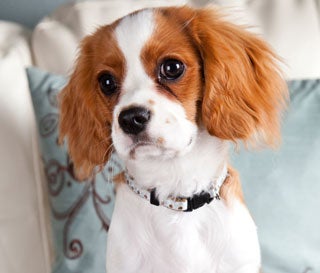Learn about dog breeds
Detailed information & photos on over 190 different breeds
Description
An adorable, graceful, active toy dog, the Cavalier King Charles Spaniel is a well-balanced, fearless, affectionate, gentle dog. An excellent companion and family dog, they get along wonderfully with older children, friends, other family pets and dogs. Cavalier are active but not excessively energetic so are happy as a lap dog, foot warmer, sitting next to their master or running in a field, playing, or going for a walk.
The Cavalier looks very much like the King Charles spaniel, which is a larger dog often used for hunting and as gun dogs. They stand between twelve and thirteen inches high at shoulder and weight from ten to eighteen pounds. They appear to have an almost square body. Cavaliers have beautiful, round, dark, soulful eyes that give the dog a gentle, sweet expression and drooping, long ears with abundant feathering. A slightly tapered, full muzzle, well developed lips, black nose, well-developed nostrils, give the dog an adorable look.
The Cavaliers silky, moderate length coat is free from curl with feathering on their tail, legs, chest, ears, and feet. Slightly crested or arched at the back, the Cavalier dogs neck is of proportionate length and muscular. The body, ribcage, and chest are strong and deep with legs that are well developed and moderately muscled, giving the dog a sturdy balance and stance.
Although docking of the Cavaliers tail is optional, most owners choose to leave the tail natural. Always carried horizontal with the ground and body, these happy little dogs’ tails always seem to be in constant motion.
Coat Description
Cavaliers have beautiful, silky, medium length coats that are sometimes slightly wavy. When fully grown, they have feathering on their tail, legs, feet, chest, and ears. The four coat colors are black and tan, ruby, tricolor, and red and white.
History
A comparatively new breed created less than one hundred years ago, the Cavalier King Charles Spaniels prototype is the toy spaniel. That little dog was a companion to nobility and royalty for many centuries. Descended from small toy spaniels including the King Charles spaniel, Cavalier are recorded in paintings from the sixteenth to eighteenth centuries although they were unknown by that name. It was not until the 1940’s that they classified the Cavalier as a separate dog breed and 1996 when they achieved toy group breed status at the American Kennel Club.
Temperament
The Cavalier King Charles Spaniel is an affectionate, eager, tail-wagging dog with a fantastic temperament and perfect for families, singles, couples, and the elderly. Although sportive, outgoing, and lively at times, these little dogs need companionship and love being with their human family, following them around, playing, or just curled up on their owners lap. The Cavalier is a loving dog that requires human attention so are not well suited for anyone that is away often or going to leave the dog alone all day on a regular basis. Left alone a lot, these dogs often display negative behavior such as continuous barking, destroying things, or dirtying in the house.
Obedient, friendly, sweet, and affectionate, Cavaliers love to please people, have wonderful temperaments, and are excellent with older children, pets, other dogs, family, and friends. Although Cavalier will bark when a stranger is on the property or comes to the door, these dogs like almost everyone so do no make good guard dogs. Cavaliers do require obedience training and socialization as some are timid, territorial, or chase cats and other pets. Training teaches the dog what is and is not acceptable and builds up its confidence.
Health Problems
Although Cavaliers are generally a very healthy breed of dog, they can sometimes experience health problems such as:
[-]Patellar Luxation – The dogs knee joint slides out and in place causing severe pain.[/-]
[-]Hip Dysplasia – Genetics, diet, and environment may contribute to hip dysplasia, which is a deformed hip joint.[/-]
[-]Otis Externa – Many dogs with folded ears have chronic ear infections.[/-]
Other conditions occasionally found in these spaniels are allergies, mitral valve disease, heart murmurs, and deafness.
Grooming
Cavaliers are average shedders that are very easy to look after. They require brushing three to five times a week using a firm bristle brush and comb. The feathered, longer hair on the legs and ears has a tendency to mat and tangle so be sure to check and comb those areas out carefully. Bathe the Cavalier using a mild, good quality dog shampoo or dry powder shampoo when necessary. Trim the hair between the dog’s footpads using grooming scissors with a blunt edge. Gently apply pressure on the bottom and top of the foot to spread the pads apart, remove any trapped debris, mats, and trim the hair. Be sure to check your dog’s ears, eyes, mouth, and skin for any signs of infection, irritation or injury.
Exercise
The Cavalier is an indoor dog that does well in the city, suburbs or countryside, in an apartment, small home or large mansion. They require regular exercise but are extremely adaptable so are happy going for a walk, playing in the house, or running with their owner. A small fenced yard is ideal for exercise. Cavalier will take off chasing a bird, squirrel, or other interesting prey so it is important to keep the dog on a lead or in a secure fenced area when outside. They are tiny and could dart in front of a vehicle with tragic results.
Training
The Cavalier King Charles Spaniels are very intelligent and easy to train using positive, gentle obedience reinforcement methods. They are a naturally well-behaved dog but still require socialization and training at an early age. The more sights, sounds, people, places, animals, and situations the Cavalier experiences as a puppy then the better behaved and more confident he is as an adult.
Advertise | Privacy Policy | Terms of Use | Contact Us © Copyright 2004-2024 PupCity.com. All rights reserved.
